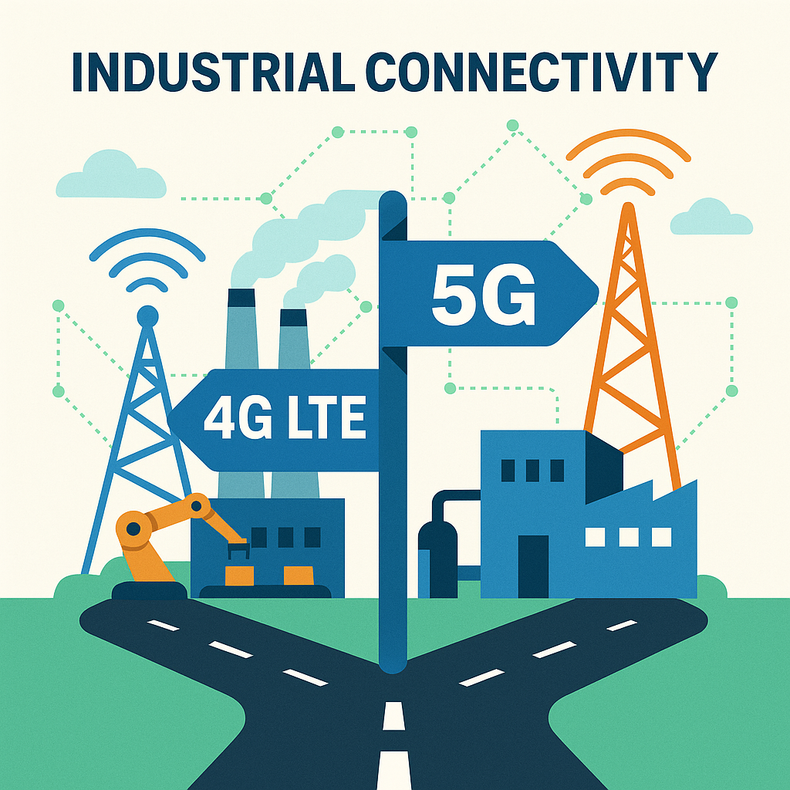As industrial operations increasingly depend on real-time data, remote monitoring, and always-on connectivity, choosing the right network technology is more critical than ever. At AG Antenna, we design and engineer advanced antenna systems that support both current and next-generation industrial wireless demands. This post explores the key differences between 4G LTE and 5G and how this evolution in wireless networks impacts connectivity strategies in industrial applications.
Understanding the Basics
What is 4G LTE?
4G LTE (Long-Term Evolution) has been the workhorse of wireless connectivity for over a decade. Known for its broad coverage, low latency (typically 30–50 ms), and respectable speeds of up to 1 Gbps under ideal conditions, LTE powers a vast number of industrial deployments—from remote telemetry systems to mobile command centers. Its mature infrastructure makes it reliable and widely compatible with a variety of routers and gateways.
What is 5G?
5G introduces a leap forward in wireless performance. Offering ultra-low latency (as low as 1 ms), enhanced device density (up to 1 million devices per square kilometer), and multi-gigabit speeds, 5G is built for high-demand applications like autonomous vehicles, AI-driven analytics, and time-sensitive automation systems. However, its availability is still growing—especially in rural and industrial fringe areas—and its deployment may require significant infrastructure upgrades.
Industrial Connectivity Requirements
Industrial environments—from factory floors and smart grids to remote pipelines and logistics hubs—demand consistent, high-performance wireless connectivity. These sectors rely on:
- Low latency for machine-to-machine communication and real-time decision-making
- High bandwidth for video feeds, sensor arrays, and diagnostics
- High reliability and uptime for mission-critical systems
- Support for dense deployments of IoT and IIoT devices
Selecting the appropriate wireless network is not just about speed—it's about matching technical requirements to environmental and operational constraints.
4G LTE vs. 5G: Head-to-Head Comparison
|
Feature |
4G LTE |
5G |
|
Latency |
30–50 ms |
1–10 ms |
|
Peak Throughput |
Up to 1 Gbps |
Up to 10+ Gbps |
|
Device Capacity |
~100,000 devices/km² |
~1,000,000 devices/km² |
|
Coverage |
Ubiquitous, global |
Growing, more urban/metro-focused |
|
Maturity |
Fully deployed and stable |
Emerging, with evolving standards |
While 5G clearly outpaces LTE in performance, LTE’s proven stability, broader coverage, and existing infrastructure still make it a practical choice for many use cases—especially where absolute latency or throughput is not a critical factor.
Practical Considerations for Decision-Makers
Deployment Location and Coverage
4G LTE is available virtually everywhere, making it ideal for deployments in rural, industrial, or mobile settings. 5G, particularly mmWave, is mostly limited to urban or campus environments due to its short range and higher propagation losses. Enterprises may consider Private LTE or 5G networks to gain more control over coverage and performance in localized industrial zones.
Equipment Compatibility
Many industrial routers and gateways are still optimized for LTE or include LTE as a fallback to 5G. Modular platforms like Cradlepoint, Pepwave, and Sierra Wireless are increasingly offering dual 4G/5G radios. AG Antenna provides external antenna systems fully compatible with these platforms, ensuring optimal signal strength regardless of network generation.
Antenna and Frequency Band Support
5G introduces new sub-6 GHz and mmWave frequency bands, requiring antennas that are not only broadband but also tuned for emerging bands. AG Antenna’s solutions—such as the AG60 and AG90 Series—are engineered with wideband, multi-MIMO, and future-ready designs that support simultaneous operation across LTE and 5G networks, including CBRS, C-band, and FirstNet.
The Case for Hybrid Solutions
Many industrial users are opting for hybrid connectivity strategies—leveraging 5G where available and falling back to LTE in less covered areas. AG Antenna supports this with rugged dual 4G/5G antenna systems that eliminate the need for future rip-and-replace upgrades.
Our antenna lines feature:
- Multi-lead configurations (e.g., 8, 11, 21 leads) for advanced MIMO and dual-modem systems
- Rugged, low-profile housings suitable for harsh environments
- Custom cable lengths and mounting options for flexible deployment
These features provide not only performance but investment protection as network technologies evolve.
Choosing the Right Antenna for Your Network
Whether you are deploying to a static industrial site or a mobile asset fleet, choosing the correct antenna is crucial. Factors to consider include:
- Number of leads and MIMO requirements
- Supported frequency bands (including new 5G NR bands)
- Physical mounting options and cable routing
- Ruggedization and environmental sealing
AG Antenna’s portfolio includes industry-leading models like the AG611 Enterprise Series, the AG68 8-Lead LTE/CBRS Solution, and the AG99 Low-Profile 9-Lead 5G/WiFi/GPS model, each purpose-built to match the needs of industrial clients navigating network evolution.
The shift from 4G LTE to 5G brings powerful advantages—but also new complexities in planning, infrastructure, and equipment. In many industrial settings, a smart, phased approach that leverages both technologies is the most cost-effective and reliable strategy. AG Antenna stands ready to support that transition with high-performance antenna solutions designed to maximize connectivity—today and tomorrow.
Contact AG Antenna’s solution engineers to discuss your specific application needs and discover the right antenna system to support your wireless strategy.

